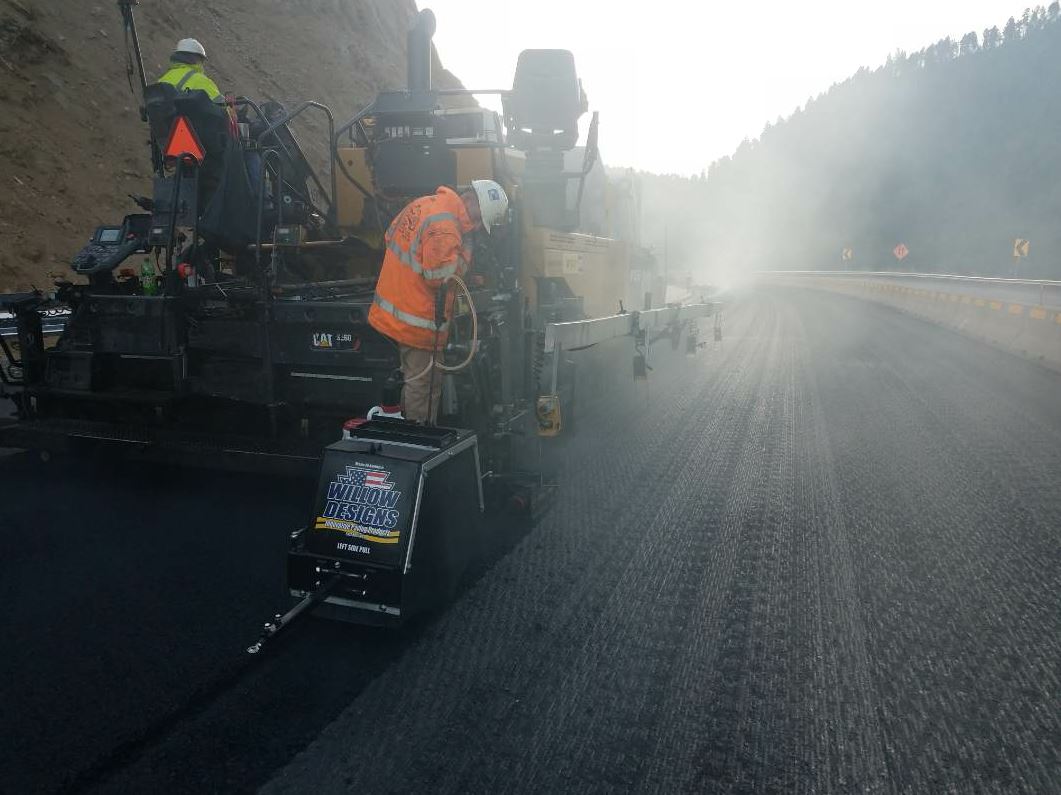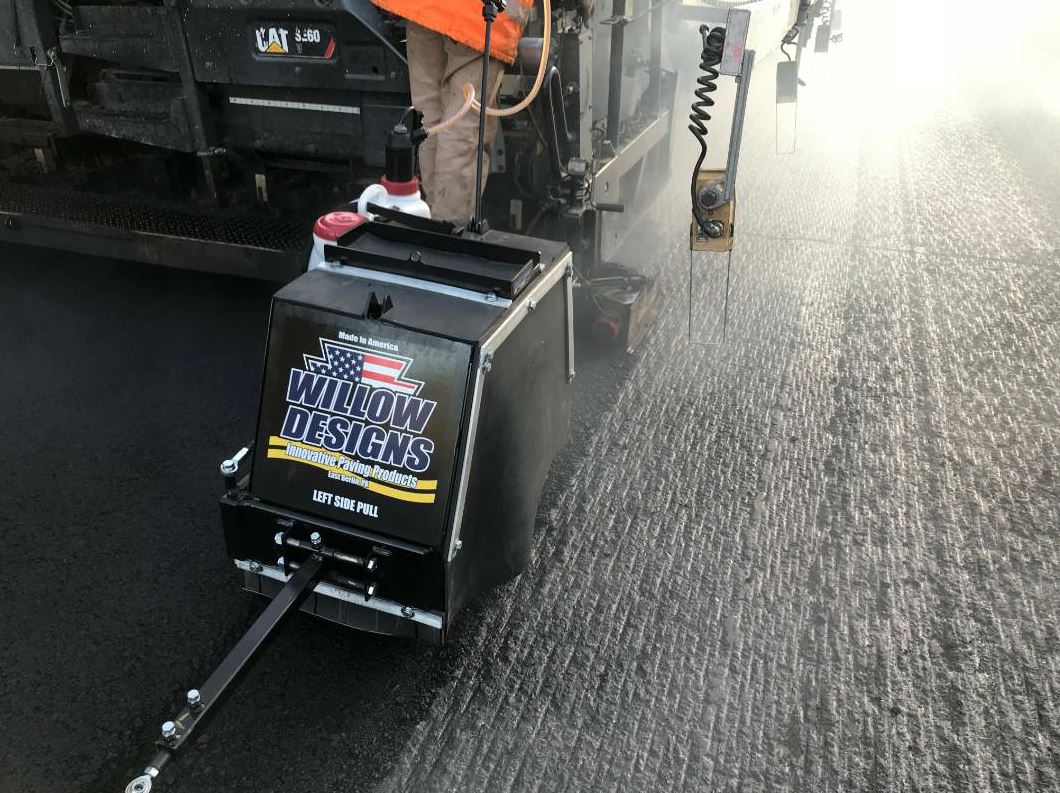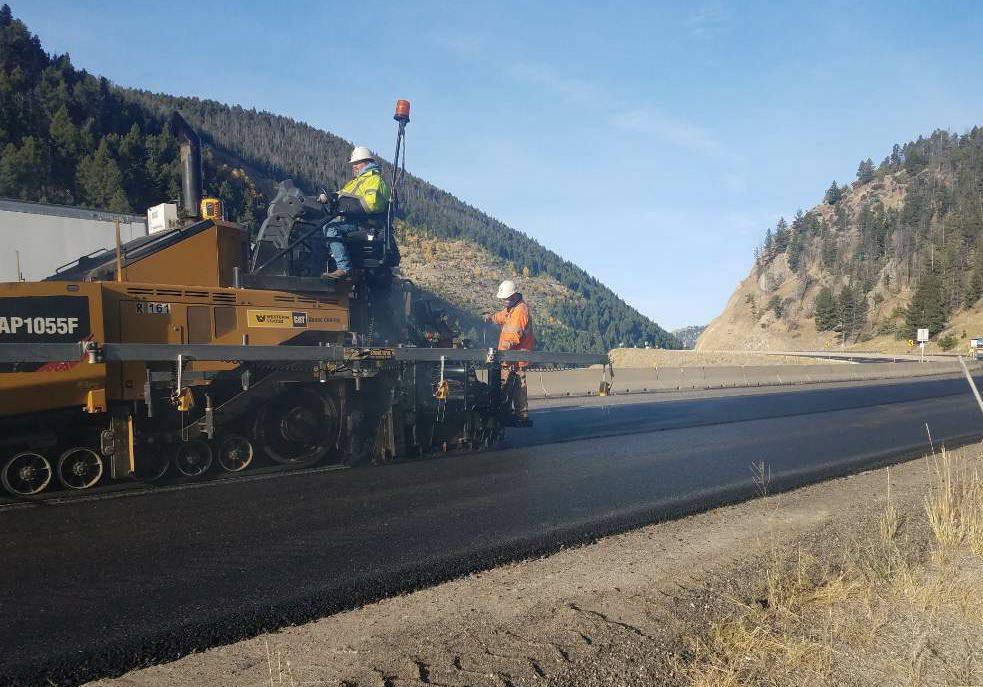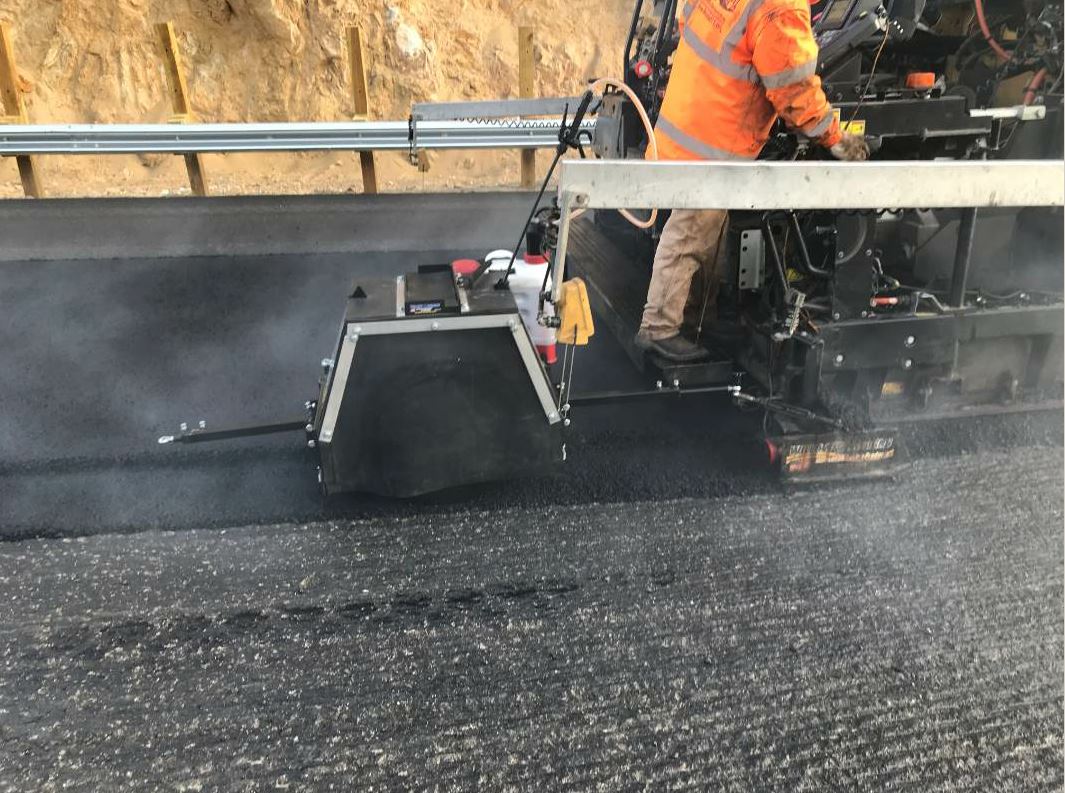Schellinger Construction Hits Notch Wedge Joint Density Specs
BY AsphaltPro Staff

It isn’t much of a stretch to say that Schellinger Construction, Columbia Falls, Montana, never uses the same mix twice. Of course they do, but the general contractor’s paving crews are almost always on the move, transporting the company’s Astec 400 ton-per-hour double barrel and CMI E3 400 asphalt plant to jobs all around central and western Montana.
One constant, however, is the need to properly compact notch wedge joints.
“Around 80 to 90 percent of our jobs are for the Montana Department of Transportation,” said Schellinger’s Manager of Asphalt Operations Bob Warren.
That’s why Schellinger purchased a notched wedge joint and pneumatic roller system from Willow Designs, East Berlin, Pa.
“Montana continues to raise the bar on joint density,” Warren said. “This notch wedge joint and pneumatic roller system gives you a fighting chance to hit compaction on that edge.”
Specifications for gently sloping safety edges, also known as notch wedge joints, have become common across North America. Montana’s Department of Transportation requires notch wedge joints on its projects, and began offering a pay factor related to joint compaction over the last few years, Warren said.
“It’s both a method spec and an end-result penalty,” Warren added. “There is money to be made, or lost, with joint compaction. We take it very seriously.”

Schellinger Construction purchased the notch wedge joint apparatus from Willow Designs in 2017. In 2018, the company added Willow’s pneumatic roller, seen here, behind it.
Prior to purchasing the notch wedge joint system from Willow, Warren had built his own device around four years ago. “It worked fairly well, but this one is way more user friendly and adjustable,” Warren said, adding that Willow’s notch wedge joint device can be raised or lowered, angles can be adjusted, and there is a specific device for both the right and left side of the paver (the pneumatic roller is adjustable to either side). “My homemade one wasn’t nearly as handy or as portable as this one.”
The results of his homemade device were also a bit more hit or miss, Warren added.
Warren began looking for a more reliable solution. “I asked around and found that a lot of my competitors were using Willow’s device,” he said.
Last year, the company purchased the notch wedge joint apparatus. This year, they tacked the pneumatic roller, which they call R2D2 for the way it wobbles along behind the paver, behind the notch wedge joint apparatus to ensure proper compaction of the joint.
So far, Schellinger’s crew has used the notch wedge joint device on about a dozen jobs, and its new pneumatic roller on two.
In September and October of 2018, the crew used the entire system on an 8-mile job on Interstate 15 near Boulder, between Helena and Butte, Montana. Schellinger Construction was selected as the low bidder on the $8.5 million project, which included milling and replacing 2.4 inches of asphalt across 16 lane miles. The job required a total of 36,000 tons of hot-mix asphalt.
The crew had to contend with many curves and 10 bridges where the interstate passes over the Boulder River. “That’s more than 60 bridge connections,” Warren said.

Warren estimates that 80 to 90 percent of Schellinger Construction’s jobs are for the Montana Department of Transportation.
Other challenges included having one lift with which to achieve a smooth ride, on top of a 2.4-inch milled (rather than profile milled) surface, no less. There were also the challenges of varying conditions along the road, such as intermittent sunshine, and the properties of PG 70-28 ¾-inch asphalt.
“PG 70-28 can be pretty stiff,” Warren said. “Compaction can be hard to achieve with that AC and those conditions.”
Schellinger earned bonuses for rideability, volumetrics and density on the Boulder job. They even made a small bonus on joint density. Warren estimates that the crew hit the joint density spec 80 to 85 percent of the time, compared to 70 to 75 percent of the time before they began using the pneumatic roller.
“It definitely improved our compaction on the Boulder project and left behind a better looking mat on the surface of the wedge,” Warren said. The other job it used the entire system on was a $12 million job west of Missoula, using PG 64-28 half-inch mix. On that job, Warren said, the joint density was a bit more hit-or-miss.
“The spec is 91 to 94 percent within 6 inches of the centerline joint, and while we had a lot in that range, we also had a smattering of 88s, 89s and 90s,” Warren said. “I really wanted to get to the point where our minimum was 91.”
On the first job with the pneumatic roller, Willow Designs’ proprietor, Jerod Willow, came to Schellinger’s job site to provide guidance on the system.
“It’s easy to get stuck doing the same things the same way just because that’s how we’ve always done it,” Warren said. “It was good to have a fresh set of eyes watch our operation and offer new ideas, especially when it’s someone with Jerod’s background and his focus on this one aspect of paving.”

Specifications for gently sloping safety edges, also known as notch wedge joints, have become common across North America. Montana’s Department of Transportation requires notch wedge joints on its projects.
Results were already improving by their second job with the system.
“We still had a couple high or low results, but a lot of that was getting used to a different apparatus,” Warren said. “I think the more projects we put under our belt using it, the more we will improve.”
Willow offered a number of tips, many of which are available in the sidebar of this article.
Clients who purchase a notch wedge pneumatic roller get one shift of support anywhere in the united States or Canada from Jerod Willow, who has more than 23 years of experience in asphalt laydown and 16 years of knowledge using notch wedge joints.
For example, Willow recommends using a double application of tack to really keep the joint together, assist in filling the voids of any minor segregation in the wedge, and aid in joint density. He also recommends staying 12 to 15 inches to the inside of the joint on the first roller pass to help stabilize the material over the notch wedge joint, and then compact the section skipped on the first pass during the second pass.
“The number one thing is the addition of the pneumatic roller,” Warren said. “The second thing is changing the breakdown sequence to force more mix into the joint.”
“We’d probably be consistently hitting 100 percent [on our joint density] if our operation wasn’t portable by nature,” Warren said. “We don’t use the same plants, the same mix, the same materials on every job, so there is always a learning curve.”
Although the unique challenges that come with Schellinger’s portable asphalt operations will always be there–with or without a notch wedge joint system–Warren is keen to improve consistencies wherever he can and the crew is rapidly closing in on any learning curve surrounding how to use Willow’s notch wedge joint and pneumatic roller system.
“We have a small sample size to look at, but the philosophy of it and the thought behind it is correct,” Warren said. “There’s no doubt that the notch wedge and pneumatic roller is the way to do it.”
Best Practices of Building, Compacting Notch Wedge Joints
Jared Willow, proprietor of Willow Designs, shares his top tips for making notch wedge joints with Willow Designs’ system.
Depth
Willow recommends that the depth of the notch be between 35 and 50 percent of the compacted mat, with 40 percent being ideal. When dialing in the depth of the notch, he warns to compensate for the compaction depth of the mat, and to check the notch’s depth after the first roller finishes its compaction pattern.
Wedge
The wedge, Willow adds, should be as smooth as the mat behind the paver screed. “The edge–the thinnest part of the wedge–should be no less than the maximum nominal aggregate size in the HMA being placed,” he said. “This will help to eliminate depth segregation.”
“A common misconception is running the notch wedge joint as tight as possible, to the point that the wedge is almost non-existent, with major depth segregation in the mix in the 12-inch wedge,” Willow said. “The major problem with this is the 12-inch segregated wedge in the joint will never get compacted and will be destined for failure.”
Tack
Willow recommends a double application of tack, “if using anything other than PG tack codes” like Pennsylvania’s specs. He suggests spraying the vertical edge of the notch wedge and the entire 12-inch wedge.
“We like to see the tack so heavy in the joint that it’s almost running off the wedge,” Willow said, “because we don’t want the joint to come apart and if there is any minor segregation in the wedge this will help fill the voids and aid in joint density.”
Compaction
To properly compact your notch wedge, placed at an appropriate depth, Willow recommends using the notch wedge pneumatic roller.
The pneumatic roller has a patent-pending steering system, which allows for lateral adjustment of the pneumatic roller tracks behind the paver. It assists with the stabilization of the 12-inch wedge.
“We don’t like to call it compaction because we do not want to fully densify the 12-inch wedge until the adjacent lane is placed on top of it,” Willow said, adding that this is why Willow Designs uses a pneumatic rather than a steel drum. “Since the wedge is essentially a thin lift, using a pneumatic will knead and tighten the mix in the 12-inch wedge without breaking aggregate.”
The sidewall of the pneumatic tire roller will also re-establish the vertical edge of the notch. “As the notch wedge joint is being built at the paver, segregation takes place where the edge of the mat and the notch wedge joint meet,” Willow said. “We like to refer to this as ‘the fluff in the joint’.”
The “fluff in the joint” can be eliminated by adjusting the steering system on the pneumatic roller to cut the mainline mat by 1/2 an inch to 1 1/2 inches to create a new vertical edge for the notch. Willow said this will yield higher density numbers on the open edge of the joint prior to placing the second pass or adjacent lane.
When doing the rest of your rolling, Willow recommends staying 12 to 15 inches to the inside of the joint on the first roller pass. “This stabilizes the material over top of the notch wedge joint,” he said. On the second roller pass, the roller should shift over to compact the 12 to 15-inch section it skipped on the first pass. “This will force the material straight down into the joint.”
Then, he said, continue rolling the rest of the mat as normal.
Match the Joint
Whether paving the second pass or an adjacent lane, Willow said it’s critical to overlap while matching the joint. “You don’t want an open joint, but you also don’t want too much overlap,” he added. The overlap should be between 1/2 an inch to 2 inches, based on the HMA mix and depth.
“Match height on the joint is also critical,” Willow said. “This is where you will have to experiment a little based on different mixes, depth of the notch, and depth of the HMA mix total.”
A trick he uses when matching the joint on a notch wedge joint is to check the mat depth 15 inches from the joint. “If this area is short on HMA mix depth, increase the main screed depth while adding a little positive slope on the joint matching extension so the joint will still roll in during compaction,” Willow said. “This minor adjustment will still provide a flat profile of the finish pavement on the second adjacent pass after compaction, but will provide more material in the joint to get density.
“From a visual standpoint on a properly matched joint, we like to see a white line of crushed aggregate the width of the overlap on the joint,” Willow said. “A joint that disappears is a future failure.”
Equipment Maintenance
It’s imperative to use a green release agent prior to paving, one that is not cut with water.
“It’s intended for the pneumatic tire to heat up from the HMA mix,” Willow said. “The green release agent will allow this to occur while still providing lubrication so the HMA doesn’t stick to the tire. Release agents cut with water do the exact opposite. They cool the tire, which will cause major pick up of HMA mix on the tire.”
Once the pneumatic tire is heated up, reapplication of release agent should be every 15 to 45 minutes, depending on the mix being placed.
